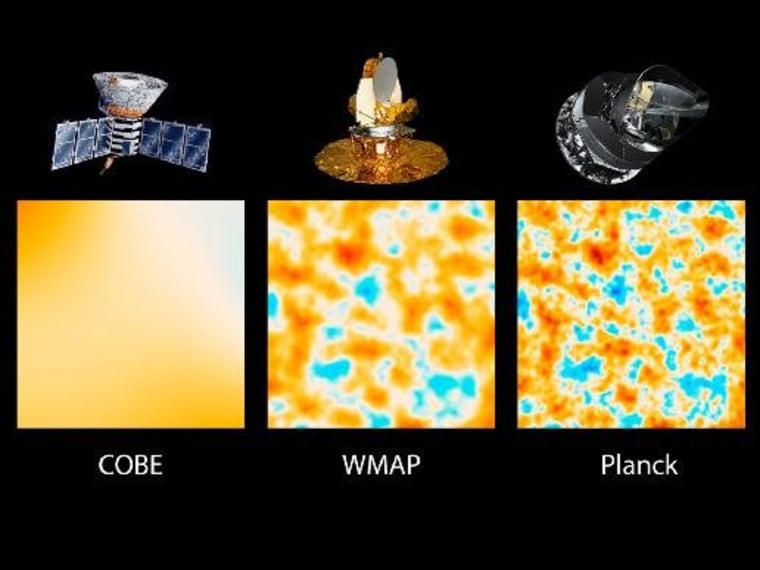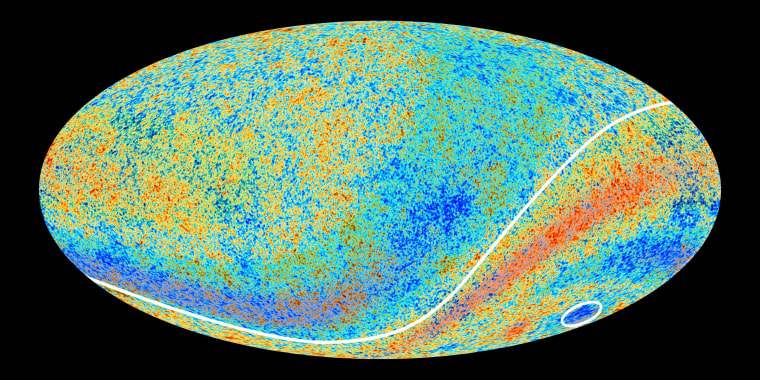The European-led team behind the Planck cosmology probe on Thursday released the mission's first all-sky map of the cosmic microwave background — a post-big-bang "baby picture" that suggests our universe is about 100 million years older than scientists thought.
The map traces subtle fluctuations in temperature that were imprinted on the deep sky when the cosmos was just 370,000 years old. Scientists say the imprint reflects ripples that arose as early as the first nonillionth of a second of the universe's existence. These ripples are thought to have given rise to today's vast cosmic web of galaxy clusters and dark matter.
"To a cosmologist, this map is a gold mine of information," University of Cambridge astrophysicist George Efstathiou, a member of the Planck science team, said during a European Space Agency news conference in Paris. He joked that not long ago, cosmologists might have "given up their children" to have such a map in their hands.
The $900 million (€700 million) Planck probe was launched on a European Ariane 5 rocket in 2009, along with the infrared-sensitive Herschel space telescope. Planck produced its first all-sky radiation map in 2010. Since then, scientists have fine-tuned the image to remove the bright emissions from the Milky Way and other foreground sources, leaving only the background radiation.
Two NASA satellites — the Cosmic Background Explorer and the Wilkinson Microwave Anisotropy Probe, also known as COBE and WMAP — produced earlier versions of the baby picture. Those findings determined that the universe is made up of 4.5 percent ordinary matter, 22.7 percent dark matter, and 72.8 percent dark energy. The results also showed that the universe is geometrically "flat" to a margin of error of 0.4 percent, and helped scientists estimate the universe's age at 13.7 billion years.

Planck can produce cosmological maps with three times the resolution of WMAP, and at least 10 times the temperature sensitivity. As a result, the estimates of the universe's age and composition have undergone some additional fine tuning. Planck's readings indicate that the universe's expansion rate is slower than previously thought — which means the universe is older.
Planck's estimate for the age of the universe is 13.82 billion years.
Martin White, a member of the Planck team from the University of California at Berkeley, told NBC News that Planck's estimate narrowed down the error bars on previous estimates. "In that sense, it's very consistent, but much more precise," he said.
The Planck team's breakdown of the universe's constituents is 4.9 percent ordinary matter, 26.8 percent dark matter and 68.3 percent dark energy, he said. "There's less stuff that we don't understand, by a tiny amount," Efstathiou said. As a result of the shift toward more matter and less dark energy, "an awful lot of people are going to be revising their calculations," White said.
Efstathiou said the Planck data also pointed to some "strange features" in the cosmic microwave background that may point to new frontiers in physics, including an unexplained dip at one point of the power spectrum, and an unusual distribution of large-scale fluctuations that roughly followed the plane of the solar system.
"Why characteristics of the CMB should relate to our solar system is not understood. ... I was explicitly told not to say anything about God in this talk — which I've just violated," Efstathiou said half-jokingly.

Planck's data set should help scientists do a reality check on many of the hypotheses proposed by cosmologists, including the view that the universe underwent rapid and far-reaching inflation in the first moments of its existence, as well as the claim that there are six or seven spatial dimensions in addition to the three we perceive.
An initial reading of the data appears to favor the simple models for the inflationary big bang, and rule out a lot of the complex models. "We think that they will be facing a dead end," said Krzysztof Gorski, a member of the Planck team from NASA's Jet Propulsion Laboratory.
ESA Director General Jean-Jacques Dordain noted that so far, the mission has delivered just half of the data it's expected to produce. The rest of the data is scheduled to come out in 2014 and 2015. "Today is not the end of the story," he told reporters. Efstathiou put it another way, paraphrasing one of Arnold Schwarzenegger's best-known catchphrases: "We'll be back."
More about cosmology:
- WMAP scientists unveil their best 'baby picture'
- Japanese string theorists simulate big bang
- Scrunched-up dimensions untangled
Alan Boyle is NBCNews.com's science editor. Connect with the Cosmic Log community by "liking" the log's Facebook page, following @b0yle on Twitter and adding the Cosmic Log page to your Google+ presence. To keep up with Cosmic Log as well as NBCNews.com's other stories about science and space, sign up for the Tech & Science newsletter, delivered to your email in-box every weekday. You can also check out "The Case for Pluto," my book about the controversial dwarf planet and the search for new worlds.
